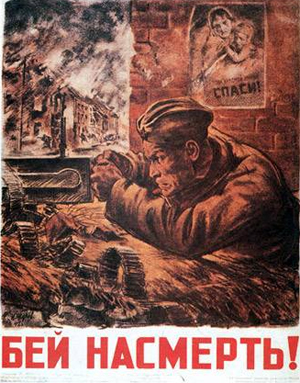Having made great strides in the conquest of Persia, the Soviet Union was caught badly off-guard by an American invasion in the Far East, and by the 28th of October, 1942, the Americans would make great strides, surrounding Vladivostok to begin what would be a siege lasting nearly four months. Initial probing attacks on Vladivostok were thrown back with ease, and units of the VVS were flown to airfields in the city to provide the close air support that, in the end, gave the defenders of the city a fighting chance. Going into November, it became clear that further forces would be required, and reinforcements from the Moscow region and the recent war in Turkey were put on trains to join the fight. They would arrive in just over one month's time.


In the north, the Soviet commanders decided to fall back across the Amur river, ceding the cities of Komsomolsk and Nikolayevsk to the invading American forces. An infantry corps under Rybalko was trapped in Komsomolsk, however, and on the second of November, an attack on Birobidzhan commenced to free it.

The Soviets had a local advantage in numbers, and the Americans, fresh off the transports, were in no position to contest the attack. Birobidzhan fell on the 12th, one day before Persia would surrender, freeing more troops for the Soviet counterattack.

The first Soviet reinforcements arrived on the 16th, a motor army under the storied General Vassilevsky. On the same day, the Soviet forces in Komsomolsk-na-Amure fell, only a day before the relieving force under Gamarnik opened the way for them to retreat. There were victories as well, however; the Soviet forces had achieved their short-term goal of pushing the Americans back past the Amur, and would soon be able to push across themselves.
On the seventh of December, Zhukov's army and headquarters elements arrived in the Far East, and moving into Blagoveshchensk, prepared for attacks on Nikolaeyvsk, in concert with Gamarnik's army and Fediuninsky's corps, in addition to other elements. The attacks on Nikolayevsk began in early January, 1943; the thrust at Komsomolsk was delayed by weather and bad roads and would not begin for two weeks, a move that cost the Soviet forces dearly.

Fediuninsky's tanks and motorized infantry secured the eastern outskirts of Nikolayevsk-na-Amure on the 15th of November, and were immediately attacked by US Marines defending Komsomolsk, reinforced by units on the coast to the east of Nikolayevsk. Outnumbered, Fediuninsky's tanks were ordered to hold Nikolayevsk at all costs. The attacks on Komsomolsk came the next day, but relief would not come for Fediuninsky until the 21st, when the American commander in Komsomolsk ordered a general retreat. By mid-February, Soviet forces had reached the coast and turned toward Vladivostok.


Meanwhile, the brave defenders of Vladivostok had, with the support of the VVS, endured multiple attacks by a foe twice their number: once in early November, once from the 17th to the 23rd of December, and again on the 15th through 22nd of January. The final attack on Vladivostok began on February 3rd, in much the same manner as the previous ones: eleven American divisions moved on the city, met in the trenches by the under-equipped defenders and pounded from the skies by the heroes of the VVS. Delaying actions along the coast prevented the Soviet relief forces from even so much as nearing Vladivostok, however, and without supplies or heavy weapons, the defenders of Vladivostok were reduced to isolated pockets. General Petrovsk, the commander in the city, was killed on the 19th, and on the 20th of February, 116 days after the siege began, Vladivostok's defenders surrendered.


Eleven more American divisions stymied the progress of the Soviets down the coast, bringing them to a numerical disadvantage of only two to three. Reforming and preparing for new attacks would cost the Soviets almost a month, but greater problems were before them. On the 7th of April, 1943, at 11:00 Moscow time, the Axis declared war on the Soviet Union.

---
Right! War with Germany. Let us discuss strategy. I've already cleared out the naval and air stuff from the production queue (it'll just have to wait), in favor of massive expansions in our infantry production. That bit isn't up for debate; we have a ton of manpower, and it's time we put it to use.
The question is this: how are we going to fight our defensive war? We have a lot of land to fall back across, so using the Scorched Earth option seems like a good idea. Whenever our units retreat, they'll destroy the province they're leaving behind, removing all infrastructure and Industrial Capacity from provinces. That ought to get Germany into supply trouble pretty quickly and limit the speed at which they can advance, which plays into our favor. They've timed their attack pretty much perfectly; we're nearly on the spring thaw, so they'll have all of summer to push deep into the USSR before the mud and snow get to them. Beyond that, what do you think?

 Poll
Poll
 Author
Topic: Arsenal of Democracy LP (1 October, 1944: Vperyod!) (Read 96028 times)
Author
Topic: Arsenal of Democracy LP (1 October, 1944: Vperyod!) (Read 96028 times)


